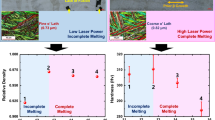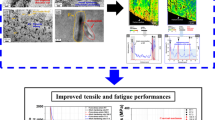Abstract
This paper proposed an electromagnetic loading process with the high-speed impact. Al-4.2% Cu alloy bars were used to employ electromagnetic impact (EI) experiments. Deformation mechanism and microstructure evolution of EI samples were revealed by theoretical model and microstructure characterizations. The EI process had impact force (peak value 40 kN) and impact velocity (peak value 6.7 m/s) during a short time period (1.25 ms). Adiabatic shearing mechanism dominated the whole deformation process, causing that significant microstructure characteristic was adiabatic shear bands (ASBs). The theoretical analysis implied that the formation of ASBs was accounted for the radial velocity gradient. Most plastic deformations concentrated in ASBs, and approximately pure shear deformations resulted in adiabatic temperature rise of 0.33–0.42 Tm inside ASBs. The width of ASBs was about 135 μm, in which original equiaxial grains were elongated into laminated sub-structures. TEM observations showed multi-slip systems were simultaneously actuated due to severe shear deformations. High dislocation density and dislocation tangles distributed with the ASBs. Adiabatic temperature rise and distorted energies drove sub-grains rotate into recrystallization grains (70–280 nm) with large angle grain boundaries. The needed maximum time (45 μs) for rotational dynamic recrystallization was far less than that of plastic deformation, indicating that rotational dynamic recrystallization mechanism contributed to the formation of recrystallization grains.
















Similar content being viewed by others
References
Zhang XX, Zhou XR, Hashimoto T, Liu B, Luo C, Sun ZH, Tang ZH, Lu F, Ma YL. Corrosion behaviour of 2A97-T6 Al-Cu-Li alloy: the influence of non-uniform precipitation. Corros Sci. 2018;132:1–8.
Nie HL, Suo T, Wu BB, Li YL, Zhao H. A versatile split Hopkinson pressure bar using electromagnetic loading. Int J Impact Eng. 2018;116:94–104.
González EV, Maimí P, Camanho PP, Turon A, Mayugo JA. Simulation of drop-weight impact and compression after impact tests on composite laminates. Compos Struct. 2012;94:3364–78.
Psyk V, Risch D, Kinsey BL, Tekkaya AE, Kleiner M. Electromagnetic forming—a review. J Mater Process Technol. 2011;211:787–829.
Zhang X, Cui JJ, Xu JR, Li GY. Microstructure investigations on 2A10 aluminum alloy bars subjected to electromagnetic impact upsetting. Mater Sci Eng A. 2017;702:142–50.
Zhang X, Cui JJ, Li GY. Microstructural mechanism in adiabatic shear bands of Al-Cu alloy bars using electromagnetic impact upsetting. Mater Lett. 2017;194:62–5.
Wright TW. The physics and mathematics of adiabatic shear bands. Cambridge: Cambridge University Press; 2002.
Tresca MH. On further applications of the flow of solids. J Frankl Inst. 1878;106:326–34.
Zener C, Hollomon JH. Effect of strain rate upon plastic flow of steel. J Appl Phys. 1944;15:22–3.
Bai YL. Thermo-plastic instability in simple shear. J Mech Phys Solids. 1982;30:195–207.
Ranc N, Taravella L, Pina V, Herve P. Mech Mater. 2008;40:255–70.
Li ZZ, Wang BF, Zhao ST, Valiev RZ, Vecchio KS, Meyers MA. Dynamic deformation and failure of ultrafine-grained titanium. Acta Mater. 2017;125:210–8.
Li JG, Li YL, Huang CX, Suo T, Wei QM. On adiabatic shear localization in nanostructured face-centered cubic alloys with different stacking fault energies. Acta Mater. 2017;141:163–82.
McAuliffe C, Waisman H. A unified model for metal failure capturing shear banding and fracture. Int J Plasticity. 2015;65:131–51.
Bejjani R, Balazinski M, Attia H, Plamondon P, L’Éspérance G. Chip formation and microstructure evolution in the adiabatic shear band when machining titanium metal matrix composites. Int J Mach Tool Manu. 2016;109:137–46.
Yang Y, Jiang F, Zhou BM, Li XM, Zheng HG, Zhang QM. Microstructural characterization and evolution mechanism of adiabatic shear band in a near beta-Ti alloy. Mater Sci Eng A. 2011;528:2787–94.
Kad BK, Gebert JM, Perez-Prado MT, Kassner ME, Meyers MA. Ultrafine-grain-sized zirconium by dynamic deformation. Acta Mater. 2006;54:4111–27.
Peirs J, Tirry W, Amin-Ahmadi B, Coghe F, Verleysen P, Rabet L, Schryvers D, Degrieck J. Microstructure of adiabatic shear bands in Ti6Al4V. Mater Charact. 2013;75:79–92.
Hines JA, Vecchio KS, Ahzi SA. A model for microstructure evolution in adiabatic shear bands. Met And Mat Trans A. 1998;29:191–203.
Meyers MA, Xu YB, Xue Q. Microstructural evolution in adiabatic shear localization in stainless steel. Acta Mater. 2003;51:1307–25.
Nesterenko VF, Meyers MA, Lasalvia JC. Shear localization and recrystallization in high-strain, high-strain-rate deformation of tantalum. Mater Sci Eng A. 1997;229:23–41.
Boakye-Yiadom S, Bassim N. Microstructural evolution of adiabatic shear bands in pure copper during impact at high strain rates. Mater Sci Eng A. 2018;711:182–94.
Yang Y, Wang BF. Dynamic recrystallization in adiabatic shear band in α-titanium. Mater Lett. 2006;60:2198–202.
Zhang X, Zhu CC, Hu L, Wu HQ, Li CF. Investigations on microstructure evolution of TA1 titanium alloy subjected to electromagnetic impact loading. Arch Civ Mech Eng. 2019;19:639–47.
Wang BF, Ma R, Zhou JD, Li ZZ, Zhao ST, Huang XX. Adiabatic shear localization in ultrafine grained 6061 aluminum alloy. Mater Sci Eng A. 2016;675:221–7.
Johnson RG, Cook WH. A constitutive model and data for metals subjected to large strain, high strain rates and high temperatures. In: Proceedings of the 7th international symposium on ballistics; 1983. pp. 541–547.
Zhang X, Yu HP, Li CF. Multi-filed coupling numerical simulation and experimental investigation in electromagnetic riveting. Int J Adv Manuf Technol. 2014;73:1751–63.
Zhang X, Yu HP, Li J, Li CF. Microstructure investigation and mechanical property analysis in electromagnetic riveting. Int J Adv Manuf Technol. 2015;78:613–23.
Smallman RE. Modern physical metallurgy. Amsterdam: Elsevier; 1962.
Funding
This work was supported by the Natural Science Foundation of Hunan Province (Grant no. 2019JJ50662), Education Department of Hunan Province (Grant no. 18C0208) and National Key Research and Development Program of Hunan Province (Grant no. 2017GK2090).
Author information
Authors and Affiliations
Corresponding author
Additional information
Publisher's Note
Springer Nature remains neutral with regard to jurisdictional claims in published maps and institutional affiliations.
Rights and permissions
About this article
Cite this article
Zhang, X., Huang, Y., Meng, S. et al. Adiabatic shearing mechanism on Al-4.2%Cu alloy bars subjected to electromagnetic loading. Archiv.Civ.Mech.Eng 21, 23 (2021). https://doi.org/10.1007/s43452-020-00161-8
Received:
Revised:
Accepted:
Published:
DOI: https://doi.org/10.1007/s43452-020-00161-8




